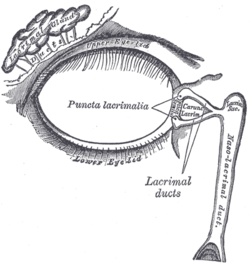| Nasolacrimal duct | |
|---|---|
 The lacrimal apparatus. Right side. | |
| Details | |
| Identifiers | |
| Latin | ductus nasolacrimalis |
| MeSH | D009301 |
| TA98 | A15.2.07.070 |
| TA2 | 6859 |
| FMA | 9703 |
| Anatomical terminology | |
The nasolacrimal duct (also called the tear duct) carries tears from the lacrimal sac of the eye into the nasal cavity.[1][2] The duct begins in the eye socket between the maxillary and lacrimal bones, from where it passes downwards and backwards. The opening of the nasolacrimal duct into the inferior nasal meatus of the nasal cavity is partially covered by a mucosal fold (valve of Hasner or plica lacrimalis).[3]
Excess tears flow through the nasolacrimal duct which drains into the inferior nasal meatus. This is the reason the nose starts to run when a person is crying or has watery eyes from an allergy, and why one can sometimes taste eye drops. This is for the same reason when applying some eye drops it is often advised to close the nasolacrimal duct by pressing it with a finger to prevent the medicine from escaping the eye and having unwanted side effects elsewhere in the body as it will proceed through the canal to the nasal cavity.
Like the lacrimal sac, the duct is lined by stratified columnar epithelium containing mucus-secreting goblet cells, and is surrounded by connective tissue.
- ^ "Nasolacrimal System Anatomy: Embryology, Puncta, Canaliculi". 2020-02-19.
{{cite journal}}: Cite journal requires|journal=(help) - ^ Herbert, Ronald A.; Janardhan, Kyathanahalli S.; Pandiri, Arun R.; Cesta, Mark F.; Miller, Rodney A. (2018). "Nose, Larynx, and Trachea". Boorman's Pathology of the Rat. Elsevier. pp. 391–435. doi:10.1016/b978-0-12-391448-4.00022-8. ISBN 978-0-12-391448-4. S2CID 80517730.
The paired nasolacrimal ducts carry lacrimal secretions from the eye to the nasal cavity, and originate as oval openings near the edge of the medial canthus of the eyelids. Initially the duct is small and circular, but in the middle portion, the diameter increases and the appearance is more oblong and saccular. The diameter again decreases before the duct enters the ventrolateral nasal vestibule medial to the root of the incisor tooth approximately 2 mm caudal to the nares.
- ^ "Medical Definition of PLICA LACRIMALIS". Merriam-Webster Medical Dictionary. 2020-05-08. Retrieved 2020-05-08.
an imperfect valve at the opening of the nasolacrimal duct into the inferior meatus of the nose